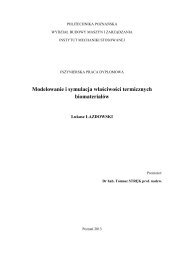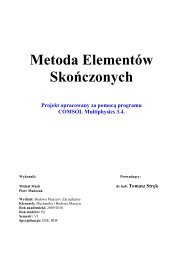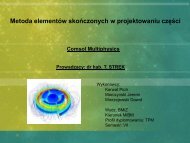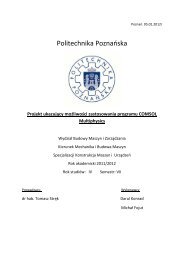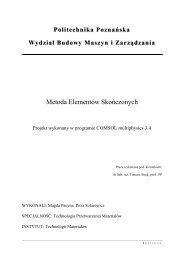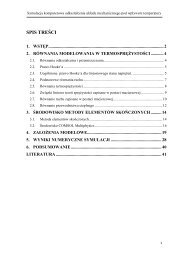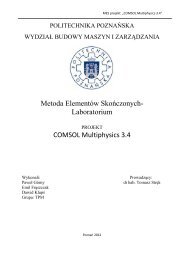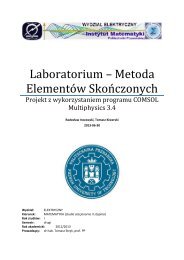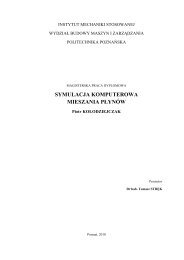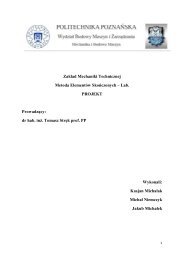COMSOL News
COMSOL News
COMSOL News
Create successful ePaper yourself
Turn your PDF publications into a flip-book with our unique Google optimized e-Paper software.
ELECTRICAL<br />
ALTASIM TECHNOLOGIES, COLUMBUS, OH<br />
Surface Plasmon Resonance<br />
BY SERGEI YUSHANOV, JEFFREY S. CROMPTON (CORRESPONDING AUTHOR), LUKE T. GRITTER, AND KYLE C. KOPPENHOEFER,<br />
ALTASIM TECHNOLOGIES<br />
Surface plasmons are coherent electron<br />
oscillations that exist at the interface<br />
between any two materials where<br />
the real part of the dielectric function<br />
changes sign across the interface. Surface<br />
Plasmon Resonance (SPR) can be used to<br />
detect molecular adsorption on surfaces<br />
and consequently is of significance for<br />
technologies ranging from gene assays<br />
The two Principals at AltaSim Technologies:<br />
Jeffrey Crompton and Kyle Koppenhoefer.<br />
and DNA sensing, molecular adsorption<br />
and desorption on surfaces, surface controlled<br />
electrochemical reactions, and<br />
nano-scale optical and photonic devices.<br />
SPR technology is based on the electromagnetic<br />
field component of incident light<br />
penetrating tens of nanometers into a surface.<br />
The stimulated resonance oscillation<br />
of valence electrons reduces the reflected<br />
light intensity and produces SPR due to<br />
the resonance energy transfer between the<br />
evanescent wave and surface plasmons.<br />
The resonance conditions are influenced by<br />
the type and amount of material adsorbed<br />
onto the surface, thus allowing characterization<br />
of surface related phenomena.<br />
SPR Models<br />
Two typical configurations of<br />
plasmon excitation exist: the<br />
Kretschmann-Raether configuration,<br />
in which a thin metal film is sandwiched<br />
between a dielectric and air,<br />
and the incident wave is from the dielectric<br />
side; and the Otto configuration,<br />
where an air gap exists between<br />
the dielectric and the metal. In both<br />
cases, the surface plasmon propagates<br />
along the metal/dielectric interface.<br />
The Kretschmann-Raether configuration<br />
is easier to fabricate but has<br />
a fixed dielectric gap that can affect the<br />
sensitivity of the measurement.<br />
Full insight into surface plasmon<br />
resonance requires quantum mechanics<br />
considerations. However, it can also be<br />
described in terms of classical electromagnetic<br />
theory by considering electromagnetic<br />
wave reflection, transmission,<br />
and absorption for the multi-layer medium.<br />
In fact the excitation of plasmon<br />
resonance can only take place if the<br />
metal side of the interface is slightly<br />
lossy, i.e. when the imaginary part of<br />
the metal permittivity is a non-zero<br />
negative number.<br />
Magnetic Field Simulation<br />
These two configurations for SPR have<br />
been analyzed using <strong>COMSOL</strong> Multiphysics<br />
to define the effect of the SPR on<br />
the electromagnetic field. It can be seen<br />
that the angle of resonance is sensitive<br />
to both the experimental configuration<br />
used and to the dielectric constant of the<br />
material adjacent to the metal surface.<br />
Using the analytical approaches demonstrated,<br />
the effect of different surface<br />
and experimental configurations on the<br />
SPR response can be defined, and has<br />
allowed the development of commercial<br />
technology for the measurement of surface<br />
contaminants and nano-scale photonic<br />
devices. n<br />
Figure 1. Magnetic field distribution at resonance condition for the<br />
Kretchmann-Raether configuration.<br />
Figure 2. Magnetic field distribution at resonance condition for the Otto<br />
configuration.<br />
3 4 // <strong>COMSOL</strong> NEWS 2 0 1 2<br />
<strong>COMSOL</strong> <strong>News</strong> 2012-17.indd 34<br />
➮<br />
Cov ToC + – A<br />
➭<br />
5/15/12 3:00 PM



